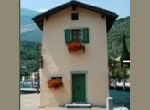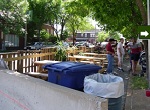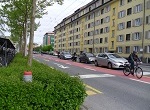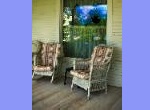Alleys Offer Important Advantages in Keeping Cars Behind Houses
Last Updated: May 10, 2025
In my travels, I notice that the advantages of alleys are being recognized in many new real estate developments, mainly those that are influenced by new urbanist principles. But in older neighborhoods, there's a movement toward beautifying, cleaning up, or even reusing them. In addition, the potential for providing environmental benefits, such as stormwater management, is being explored. In my city, sometimes the little beautification projects are even being undertaken by groups without the sanction of the city government. I shouldn't say more.
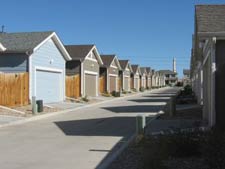
In post-World War II suburbs and during my education as a city planner, alleys were considered obsolete. After all, in older city and small town neighborhoods, they are often dirty, rodent-infested, weedy, stinky, and occasionally criminal hideouts or escape routes.
So why would anyone want to bring back this idea? Isn't the green alley a contradiction in terms?
Well, when new urbanism
began to assert itself, we as a society revisited one of the possible benefits of
the rear entranceway for cars. It is a great way to put the garage
behind the house, where
it belongs.
The front of the house should be where we have porches and sidewalks, and where we socialize. When we put mammoth garages in the front of our homes, protruding even further toward the street than our front door (resulting in what is sometimes called snout houses), it is equal to crossing our arms when we meet someone.
It is as if we say, "We don't want to interact with you. Our car is more important than our neighbor. We're going to try to get inside our house without even seeing our neighbors."
Of course, other benefits include providing a reasonable place to stash your trash, out of the view of the public, and providing an entrance to garages where the lot is not wide enough to allow a driveway from the street.
The Rise of Beautification, Cleanups, and Environmental Functionality
Now we're seeing a welcome flurry of activity in beautifying alleys. Cities large and small, as well as neighborhood groups, stage alley cleanups (that page gives my favorite alley cleanup tips), including removing wayward trash, unwanted weeds gone wild, and graffiti.
Sometimes flowers are planted, the dumpsters are lined up more neatly (until the garbage truck's lifting device plants them at a jaunty angle again), and fences are repaired or painted.
Commercial districts and downtown redevelopment projects can beautify their rear parking lots and entrances by helping or requiring businesses to repair or repaint ugly doors and windows, redo their stairways or fire escapes from the second floor, add landscaping in odd spaces, and paint or repair fences. That's in addition, of course, to the usual clean-up activities.
Keeping a rear-door circulation pattern is critical to many businesses that receive supplies from that side of the building. Making an area inviting both to delivery trucks and to human beings is a big challenge, but one that you can manage with some fencing and landscaping as screening to keep the one use away from the other.
Another approach in commercial areas is to reimagine the alley. For example, in Anderson, Indiana, an artist alley has been developed. They used string lights to encourage after-dark visits, and a rotating stable of 10 artists provide art for what used to be a dark, dingy alley; these artists are paid something too. They have been imaginative; a set of swings holds down one end of the alley, and a Facebook page keeps residents up to date on the happenings. Read more about the Anderson artist alley here.
In other places, the pavement itself can be repaired, or alternatively, it could be allowed to deteriorate into two paved strips with grass growing in between them. If any vehicular traffic is permitted, keeping the surface in good working order is much easier than completely rebuilding it later.
If the alleys are no longer functional in terms of people having a good reason to drive on them, they can be allowed to revert back to green space. We would prefer that to allowing them to be handed back to each private resident; who knows what future use the public sector or a utility may have for a linear corridor?
Ideas for Alley Projects
It's really not hard to generate ideas for improving your alley. Here as much as anywhere in your neighborhood or community, we have found that just a short walk with friends will identify what should be done. So plan that walk for the next nice day.
Make a list of all the negatives, and then as you're refreshing yourselves with a beverage together afterward, see if you can create a positive idea or two along the way. Our experience has been that neighbors really enjoy imagining picnic tables in the alley that otherwise seems too wide, and in another instance, a neighborhood we worked with decided to plant and share a narrow herb garden along on one sunny side of an alley for a length of more than two blocks.
While you are looking around, consider the possibility of adding some accessory dwelling units in the form of alley or laneway houses, modern-day carriage houses that can add reasonably priced rental housing if you are in an expensive housing market. These alley houses are an integral part of plans to increase the stock of reasonably priced housing in some U.S. West Coast cities where housing has become very pricey.
The very interesting Baltimore gating and greening program
allows residents to decide they want to block off their alley and
reclaim it for other purposes. Suggestions include cleanup, planting
grass or landscaping, picnic tables, art, painted hopscotch court, or anything else residents
want. There's talk of making yourselves safer from criminal activity as
you beautify these strips.
And the grand-daddy of all repurposing must be Chicago's green program. The City used a menu of choices to try to improve stormwater runoff practices by introducing permeable paving, reducing urban heat effects, and replacing old, energy-intensive fixtures with sky-friendly street lighting.
So if you wouldn't want to see a photo gallery of your leaning fences, weeds, dead animals, and trash on Instagram or Facebook, get busy with a spring or fall beautification, clean-up, or greening project.
For example, the Indianapolis Public Works Department has sponsored an Indy Alley Clean-Up Program, which now occurs as part of the Great Indy Cleanup. The City provides a dumpster, trash bags, and gloves for organized groups that participate.
If your alley needs to be repaved anyway, now is the time to work with your city on whether the alley could feature an unpaved and slightly depressed area in the middle of the alley, to allow more stormwater absorption.
If you're proud of what has happened behind your property, show off your clean-up project here. You can include photos! That page also includes our favorite ten tips for organizing your first alley clean up, if you're not quite sure what to consider before the big day.
Check Out these Pages Also of Interest In Thinking About Alleys
Join GOOD COMMUNITY PLUS, which provides you monthly with short features or tips about timely topics for neighborhoods, towns and cities, community organizations, and rural or small town environments. Unsubscribe any time. Give it a try.
